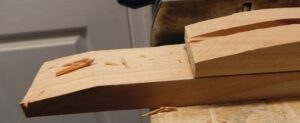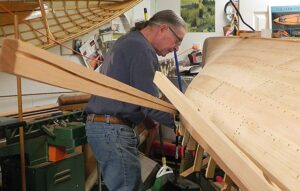The attachment of the gunwales is the last step before taking the hull off the strong back. The gunwales are integral to the hull for several reasons. First, they give added support by tying the whole hull together. Should the bow of the boat collide with with a pier, for example, that force will be safely spread away from the bow and along the gunwales, thus avoiding serious damage. The same will happen should a blow to the midships occur.
The second function of the gunwales is to offer a sturdy support for the oar locks. Howard Seaman’s racing guideboat, now on display in the Adirondack Museum, shows the strain that his oarlocks had to bear when he was racing. His oarlocks were held by bolts that ran through the gunwales and hull planking where they were securely held with washers and nuts.
The gunwale are useful in another way; they help eliminate the use of thwarts. Thwarts are cross bracing used with canoes. Canoes use steam bent ribs which are not as strong as the sawn ribs in a guideboat. Doing away with thwarts by using sawn ribs opens up the inside of the boat and makes it much easier to stow gear.
My gunwales are made of quarter sawn cherry. I learned the secret of using quarter sawn stock after wrestling with flat sawn material on my first guideboat. It is nearly impossible to get flat sawn stock to conform to the shear curve. Sometime way back someone clued me in to using quarter sawn for the gunwales. I have been forever grateful for that advice.
Why is quarter sawn stock preferred for making the gunwale? Grain in wood is really a composite material. A softer layer of the grain is laid down during the spring and summer months. Towards the end of summer a harder, denser layer forms next to the softer band. This forms what woodworkers call grain.
With flat sawn stock the grain runs roughly parallel to the top and bottom of a plank. Just the opposite is the case with quarter sawn stock where the grain runs perpendicular to the top and bottom of the plank.
When you are installing the gunwale the stock must bend upwards along the shear line. Flat sawn stock totally resists this bend. Even with steaming the gunwale it is extremely difficult to fit the gunwale to the shear curve. I suppose it is the hard layer of the grain that resists that bend. It just doesn’t want to move sideways.
On the other hand quarter sawn stock is much easier to bend along the shear line. I’m not saying it still isn’t a struggle to make it fit, because it is. But with some patience you can work your way along the shear line fastening the gunwale to each rib station. I use #6 X 3/4″ long round head screws to fasten the gunwale.
The use of quarter sawn material is no panacea, it is still difficult to install the gunwales. The gunwale stock is 9/16″ thick and 1 1/4″ thick. To make it easier to install, I ran a rabbet down the center of the hull side of the gunwale. It is the width of my table saw blade and 1/8″ deep. The photo below shows the rabbet. The rabbet has a minimal effect on the strength of the gunwale.

Here Stew is working along patiently fastening the gunwale.

With the gunwale installed we can begin in earnest to finish the inside of the hull. that’s next.